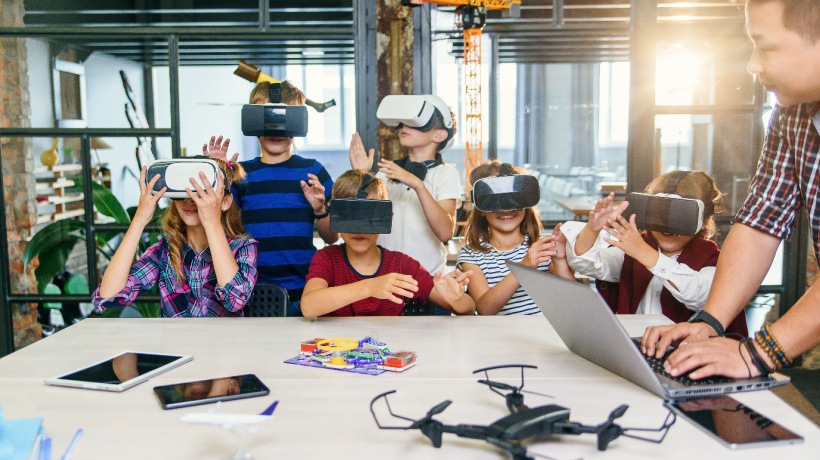Empowering The Students Of Tomorrow: A Call To Action For K-12 Educators
In today's rapidly evolving world, the landscape of education is undergoing a seismic shift. The Fourth Industrial Revolution, characterized by technological advancements, automation, and globalization, demands a reimagining of our approach to teaching and learning. As K-12 educators, we have a pivotal role to play in preparing students for the challenges and opportunities of this new era. It's time to embrace change and transform our educational practices to ensure that our students are equipped with the skills and competencies needed to thrive in the Fourth Industrial Revolution. Here's how we can take action.
Preparing Students For The Future In K-12 Education
1. Embrace Holistic Learning
Emphasize a holistic approach to education that integrates a wide range of subjects, including but not limited to Science, Technology, Engineering, Arts, and Mathematics (STEAM), to cultivate well-rounded individuals with diverse skills and perspectives necessary for navigating the complexities of the future workforce.
2. Shift To Competency-Based Learning
Move away from a one-size-fits-all approach and embrace competency-based learning, where students progress based on mastery of specific skills and competencies rather than time spent in the classroom.
3. Recognize Diverse Learning Experiences
Acknowledge the value of diverse learning experiences, including informal learning, online courses, and extracurricular activities, in developing students' skillsets. Implement mechanisms for recognizing and accrediting these experiences.
4. Integrate Emerging Technologies
Embrace emerging technologies such as Artificial Intelligence, Virtual Reality, and coding into the curriculum to prepare students for the technological advancements shaping the future workforce. Learn the trade or get acquainted with cutting-edge tools and platforms that drive innovation and efficiency in various industries.
5. Bridge The Digital Divide
Ensure equitable access to technology and digital literacy training for all students to bridge the digital divide and prevent exacerbating inequality in the digital age. Find creative solutions to address barriers such as limited internet access, lack of device availability, and socioeconomic disparities, ensuring that every student has the opportunity to develop essential digital skills regardless of their background.
6. Collaborate With Industry
Foster partnerships with industry leaders to align curriculum with workforce needs, provide real-world learning experiences, and facilitate knowledge sharing and apprenticeships for students. Talk to your friends, reach out to the private sector, and collaborate with businesses to create meaningful learning opportunities that bridge the gap between classroom learning and practical skills demanded by the evolving job market.
7. Promote Lifelong Learning
Cultivate a culture of lifelong learning by encouraging students, colleagues, and parents alike to continuously update and expand their skillsets throughout their lives, empowering them to thrive in an ever-changing job market. Jobs are transforming at a rapid pace, and staying relevant requires a commitment to ongoing education and skill development. Let's embrace the mindset of lifelong learning to adapt, grow, and succeed in the dynamic landscape of the future.
The Role Of Educators
As educators, we hold both the privilege and responsibility of guiding the next generation of leaders, innovators, and problem solvers. In the rapidly evolving landscape of the Fourth Industrial Revolution, the role of a 21st-century teacher is more pivotal than ever. We possess the transformative power to shape the future by arming our students with the knowledge, skills, and mindset essential to navigate and excel in this era of profound change.
To effectively prepare our students for the challenges and opportunities ahead, we must embrace change and innovation in our educational practices. This necessitates a shift from conventional teaching methods to dynamic and interactive approaches that foster creativity, critical thinking, collaboration, and adaptability.
Moreover, we must acknowledge the critical role of integrating emerging technologies such as Artificial Intelligence, Virtual Reality, and coding into the curriculum. This ensures that our students become proficient in the tools and technologies shaping the future workforce. By offering real-world learning experiences and forging partnerships with industry leaders, we can bridge the gap between classroom instruction and the evolving demands of the job market.
Conclusion
Navigating the complexities of the Fourth Industrial Revolution underscores the importance of fostering a culture of lifelong learning not only among our students but also among our colleagues and parents. By encouraging continuous skill development and embracing a growth mindset, we empower individuals of all ages to thrive in an ever-changing job market. Let's cultivate a collaborative environment where learning is esteemed, curiosity is nurtured, and innovation is championed. Together, let's inspire a generation of lifelong learners armed with the knowledge, skills, and resilience to lead and succeed in the digital age and beyond.

